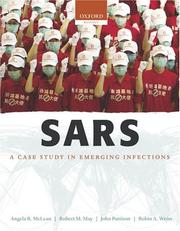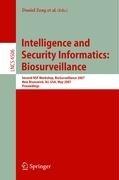| Listing 1 - 3 of 3 |
Sort by
|

ISBN: 1282335278 9786612335273 0191524476 9780191524479 0198568193 9780198568193 0198568185 9780198568186 Year: 2005 Publisher: Oxford New York Oxford University Press
Abstract | Keywords | Export | Availability | Bookmark
 Loading...
Loading...Choose an application
- Reference Manager
- EndNote
- RefWorks (Direct export to RefWorks)
The sudden appearance and rapid spread of Severe Acute Respiratory Syndrome (SARS) in 2002 served to alert the world to the fact that emerging infections are a global problem. Living in affluent societies with well developed health care systems does not necessarily protect people from the dangers posed by life-threatening infections. The SARS epidemic tested global preparedness for dealing with a new infectious agent and raised important questions: how did we do, and what did we learn? This book uses the SARS outbreak as a case study to enumerate the generic issues that must be considered when
Book
ISBN: 1280714549 9786610714544 1429423188 Year: 2006 Publisher: : World Health Organization,
Abstract | Keywords | Export | Availability | Bookmark
 Loading...
Loading...Choose an application
- Reference Manager
- EndNote
- RefWorks (Direct export to RefWorks)
Where did this frightening disease come from? How did it spread? And will the world be any better prepared if it returns? For the first time, these and other questions are answered in this remarkable inside account of what really took place in those fateful months of 2003 when severe acute respiratory syndrome threatened to engulf the world.
Communicable diseases -- Prevention. --- Communicable Diseases, Emerging. --- Communicable diseases. --- Epidemics -- Prevention. --- Public health -- United States. --- SARS (Disease) -- Epidemiology. --- SARS (Disease) -- Prevention -- Government policy -- United States. --- SARS (Disease) -- Research -- United States. --- Severe acute respiratory syndrome-related coronavirus. --- Severe Acute Respiratory Syndrome --- Disease Outbreaks --- Communicable Diseases, Emerging --- Coronavirus Infections --- Coronavirus --- Public Health --- Respiratory Tract Infections --- Communicable Diseases --- Coronaviridae Infections --- Coronaviridae --- Respiratory Tract Diseases --- Environment and Public Health --- Infections. --- Disease. --- Nidovirales Infections --- Nidovirales --- Delivery of Health Care. --- Bacterial Infections and Mycoses --- RNA Viruses --- RNA Virus Infections --- Vertebrate Viruses --- Viruses --- Virus Diseases --- Organisms


ISBN: 9783540726074 3540726071 9786610940752 1280940751 354072608X Year: 2007 Publisher: Berlin, Heidelberg : Springer Berlin Heidelberg : Imprint: Springer,
Abstract | Keywords | Export | Availability | Bookmark
 Loading...
Loading...Choose an application
- Reference Manager
- EndNote
- RefWorks (Direct export to RefWorks)
The 2007 NSF BioSurveillance Workshop (BioSurveillance 2007) was built on the success of the first NSF BioSurveillance Workshop, hosted by the University of Arizona’s NSF BioPortal Center in March 2006. BioSurveillance 2007 brought - gether infectious disease informatics (IDI) researchers and practitioners to discuss selected topics directly relevant to data sharing and analysis for real-time animal and public health surveillance. These researchers and practitioners represented a wide range of backgrounds including but not limited to epidemiology, statistics, applied mathematics, information systems, computer science and machine learning/data mining. BioSurveillance 2007 aimed to achieve the following objectives: (a) review and examine various real-time data sharing approaches for animal and public health s- veillance from both technological and policy perspectives; (b) identify key technical challenges facing syndromic surveillance for both animal and human diseases, and discuss and compare related systems approaches and algorithms; and (c) provide a forum to bring together IDI researchers and practitioners to identify future research opportunities. We are pleased that we received many outstanding contributions from IDI research groups and practitioners from around the world. The one-day program included one invited presentation, 17 long papers, six short papers, and two posters. BioSurveillance 2007 was jointly hosted by: the University of Arizona; University of California, Davis; Rutgers, The State University of New Jersey; and the University of Washington.
Public health surveillance --- Electronic surveillance --- Santé publique --- Congresses. --- Methodology --- Surveillance --- Congrès --- Anomaly detection (Computer security) -- Congresses. --- Computer science -- Congresses. --- Mathematics -- Congresses. --- Public health surveillance -- Databases. --- SARS (Disease) -- Epidemiology. --- Epidemiology --- Medical informatics --- Public Health --- Health Surveys --- Informatics --- Infection --- Information Science --- Public Health Practice --- Investigative Techniques --- Publication Formats --- Publication Characteristics --- Bacterial Infections and Mycoses --- Data Collection --- Medicine --- Analytical, Diagnostic and Therapeutic Techniques and Equipment --- Health Care Evaluation Mechanisms --- Diseases --- Environment and Public Health --- Epidemiologic Methods --- Health Occupations --- Quality of Health Care --- Health Care --- Disciplines and Occupations --- Health Care Quality, Access, and Evaluation --- Population Surveillance --- Methods --- Medical Informatics --- Communicable Diseases --- Congresses --- Engineering & Applied Sciences --- Health & Biological Sciences --- Epidemiology & Epidemics --- Computer Science --- Data processing --- Mathematics --- Computer science --- Anomaly detection (Computer security) --- SARS (Disease) --- Epidemiology. --- Population surveillance (Public health) --- Surveillance, Public health --- Acute respiratory syndrome, Severe --- Respiratory syndrome, Severe acute --- Severe acute respiratory syndrome --- Detection, Anomaly (Computer security) --- Math --- Computer science. --- Computer communication systems. --- Data mining. --- Bioinformatics. --- Computers and civilization. --- Management information systems. --- Computer Science. --- Information Systems Applications (incl. Internet). --- Data Mining and Knowledge Discovery. --- Computer Communication Networks. --- Computational Biology/Bioinformatics. --- Computers and Society. --- Management of Computing and Information Systems. --- Computer-based information systems --- EIS (Information systems) --- Executive information systems --- MIS (Information systems) --- Sociotechnical systems --- Information resources management --- Management --- Civilization and computers --- Civilization --- Bio-informatics --- Biological informatics --- Biology --- Information science --- Computational biology --- Systems biology --- Algorithmic knowledge discovery --- Factual data analysis --- KDD (Information retrieval) --- Knowledge discovery in data --- Knowledge discovery in databases --- Mining, Data --- Database searching --- Communication systems, Computer --- Computer communication systems --- Data networks, Computer --- ECNs (Electronic communication networks) --- Electronic communication networks --- Networks, Computer --- Teleprocessing networks --- Data transmission systems --- Digital communications --- Electronic systems --- Information networks --- Telecommunication --- Cyberinfrastructure --- Electronic data processing --- Network computers --- Science --- Communication systems --- Distributed processing --- Coronavirus infections --- Respiratory infections --- Syndromes --- Computer security --- Information Systems. --- Public health --- Application software. --- Application computer programs --- Application computer software --- Applications software --- Apps (Computer software) --- Computer software --- Computer networks.
| Listing 1 - 3 of 3 |
Sort by
|

 Search
Search Feedback
Feedback About UniCat
About UniCat  Help
Help News
News